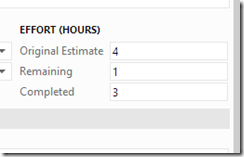Changes always happen. although you have a good client in the world, changes always happen. Requirements will change anytime, so the good practice to limit the changes is by finishing the project as soon as possible. If you can’t finish your work as soon as posible, you should monitor the changes so that it won’t hurt your team, your financial, and your mood.
Visual Studio Online has a good ALM feature to manage the changes using Work features on the web site First of first you should create project on visual studio online and choose Agile or Scrum template. For this post, we will use Agile template.
Understanding Estimation
Estimation is a way to estimate the workload and to calculate the budget that need to be invested for the project. On Agile template on Visual Studio you can set it on the story point as shown on the Figure 1.

You estimate your effort by simply adding story point on Visual Studio Online
Understanding Actual Work
Actual work is an effort that really happen for such a task. In this concept, a story has several tasks. each task will have estimation and actual. The estimation each task should be a total of a story point.
For example, if we have 24 story points and 12 tasks, so each the total story point should have 24 story points. However task has hour unit not the story point unit. Therefore, you should convert the story points unit into hours
 The big question is 1 story points = .. hour?
The big question is 1 story points = .. hour?
The answer is depend on your team velocity. You can get the team velocity by understanding team performance on the past. One of the technique to calculate the relation between story point and hour is by doing a three points approaches.
Three points approaches
The basic idea to get team velocity is to understand their real performance. This approach can be done by collecting the real experience of the team on a project. For example, on a project a team do 10 iteration. Based on the iterations,you should
- Choose the three best performance (high velocity, more story points on the same time)
- Choose the three average story points
- Choose the three worst story points
- Calculate the average for the story points
- Divide the story points with the length of iteration
You will find the average of your team velocity. However, the technique is applicable if:
- You do the similar project (i.e. web vs web)
- You have same team
- You have similar working condition
References